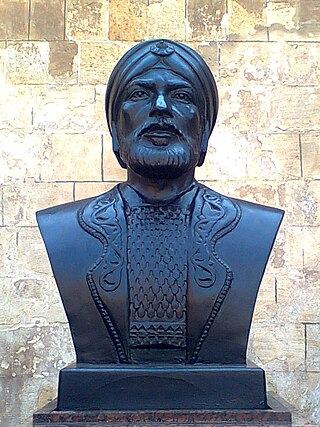Related Research Articles

Year 1258 (MCCLVIII) was a common year starting on Tuesday of the Julian calendar.

Hulagu Khan, also known as Hülegü or Hulegu, was a Mongol ruler who conquered much of Western Asia. Son of Tolui and the Keraite princess Sorghaghtani Beki, he was a grandson of Genghis Khan and brother of Ariq Böke, Möngke Khan, and Kublai Khan.

The Ilkhanate or Il-khanate, also known as the Ilkhanids, and known to the Mongols as Hülegü Ulus, was a Mongol khanate established from the southwestern sector of the Mongol Empire. The Ilkhanid realm was officially known as land of Iran or simply Iran. It was established after Hulagu Khan, the son of Tolui and grandson of Genghis Khan, inherited the Southwest Asian part of the Mongol Empire after his brother Möngke Khan died in 1259.

Qazvin is a city in the Central District of Qazvin County, Qazvin province, Iran, and serves as the capital of the district, county, and province. It is the largest city in Qazvin province.

Saif ad-Din Qutuz, also romanized as Kutuz or Kotuz and fully al-Malik al-Muẓaffar Sayf ad-Dīn Quṭuz, was a military leader and the third or fourth Mamluk Sultan of Turkic origin. He reigned as Sultan for less than a year, from 1259 until his assassination in 1260, but served as the de facto ruler for two decades.

Maragheh is a city in the Central District of Maragheh County, East Azerbaijan province, Iran, and serves as capital of the county.

The history of Azerbaijan is understood as the history of the region now forming the Republic of Azerbaijan. Topographically, the land is contained by the southern slopes of the Caucasus Mountains in the north, the Caspian Sea in the east, and the Armenian Highlands in the west. In the south, its natural boundaries are less distinct, and here the country merges with the Iranian Plateau.
Nüsnüs is a village and municipality in the Ordubad District of Nakhchivan, Azerbaijan. It is located 7 km in the north-east from the district center, on the foothill of the mountain. Its population is busy with gardening, vegetable-growing, farming and animal husbandry. There are secondary school, club, culture house, kindergarten, communications branch and a medical center in the village. It has a population of 1,905.

Akhsitan I was the 20th Shirvanshah after 1160, and thought to have reigned until the years 1197–1203/04. He was the son and successor of Manuchihr III. His mother was Tamar, a Georgian princess from the Bagrationi dynasty.
Arghun Agha, also Arghun Aqa or Arghun the Elder was a Mongol noble of the Oirat clan in the 13th century. He was a governor in the Mongol-controlled area of Persia from 1243 to 1255, before the Ilkhanate was created by Hulagu. Arghun Agha was in control of the four districts of eastern and central Persia, as decreed by the great khan Möngke Khan.

The Bibi-Heybat Mosque is a historical mosque in Baku, Azerbaijan. The existing structure, built in the 1990s, is a recreation of the mosque with the same name built in the 13th century by Shirvanshah Farrukhzad II Ibn Ahsitan II, which was completely destroyed by the Bolsheviks in 1936.
Afridun II was a Shah of Shirvan. He may have ruled during a time in Shirvanshah history that scholarship has referred to "a period of total confusion", due to the lack of written records and contradictory numismatic evidence. He was a son of Shirvanshah Manuchihr III. He had had three brothers, Akhsitan I, Farrukhzad I, and Shahanshah. He might not have even ruled. He left no numismatic evidence but known from his son Fariburz II's coins.

Shahanshah was the Shirvanshah from c. 1180 to c. 1203.
Farrukhzad I was the Shirvanshah from between 1187–1203 to sometime before 1225.

Jalal ad-din Akhsitan was the 27th Shirvanshah.
Akhsitan III was the 29th ruler of Shirvan, now part of Azerbaijan. He is thought to be the son of Shirvanshah Farrukhzad II.
The Kasranids were a branch of the Shirvanshahs, who ruled the Shirvan region for 387 years. The word "Kasra" was derived from legendary king Kai Khosrow of Iran, reflecting a shift in naming tradition from Arabic to Persian and it was part of an effort to break with their Arabic roots by claiming to be successors of the Sasanians and the Kayanian dynasty.

Pir Mardakan Khanqah is historic architectural monument located in the village of Goylar, 16 km south-west of Shamakhi district of the Azerbaijan Republic. The complex includes a tomb, a dynasty building and small auxiliary buildings. It was built in XIII–XIV centuries. According to some sources, this is the tomb of Seyid Mardakani, one of the famous scholars of his time.
The High Middle Ages, or Classic Feudalism Period in what constitutes the present-day Republic of Azerbaijan, lasted from around the 11th century to the 15th century AD. The High Middle Ages were preceded by the Early Middle Ages and were followed by the Late Middle Ages, which ended around the 15thcentury AD. Key historical trends of the High Middle Ages include the incorporation of the territories that constitute present-day Azerbaijan into the Seljuk Empire, the establishment of the Eldiguzids, the Mongol invasions and the rule of the Ilkhanate, the invasions of Timur and the establishment of the Turkoman Kara Koyunlu and Aq Qoyunlu tribal confederations.
The Mongol invasions and conquests of the territory that now comprises the Republic of Azerbaijan took place during the 13th and 14th centuries and involved large-scale raids. The Mongol invasions of Azerbaijan resulted in the incorporation of the territories of what now comprises Azerbaijan into the newly established Hulagu state.
References
- ↑ Dorn, Boris (1861). Отчет об ученом путешествии по Кавказу и южному берегу Каспийского моря[Report on a scientific trip to the Caucasus and the southern shore of the Caspian Sea] (in Russian). Saint Petersburg: Russian Academy of Sciences. p. 27.
- ↑ Ashurbeyli, Sara (2006). Shirvanshahs' State (in Azerbaijani). Baku: Poliqraf. p. 144. ISBN 978-5-87459-229-5.